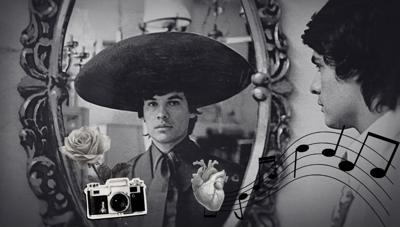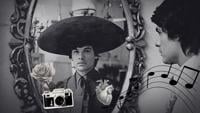
The four-part docuseries, titled “Juan Gabriel: Debo, Puedo y Quiero,” premiered on October 30. Photo design by Brenda Verano
Alberto Aguilera Valadez, more commonly known as Juan Gabriel, died in the summer of 2016. A new Netflix documentary allows many to hold his memory close again. The four-part docuseries, titled “Juan Gabriel: Debo, Puedo y Quiero,” premiered on October 30, in a time when many Latinos were preparing to honor the departed – family, friends and more – in their Día de los Muertos altars.
For me, the documentary was not only a love letter to Juan Gabriel's undoubtedly astonishing career, but it was also a glimpse into the child, son, orphan, father, friend, vulnerable, and at times, struggling creative.
I was 18 years old when Juan Gabriel died. I can still remember witnessing the tragic day on TV, as Univision broadcast his funeral procession. I recall my mother, who was making a meal, coming back and forth from the kitchen to our living room as we both watched the moments when Juan Gabriel's ashes were being driven through Mexico City’s historic center.
My mother, who grew up in Mexico City, saw thousands of people saying their final goodbye to what she and I believe to be Mexico’s most influential and talented icon.
Years later, we both gathered in that same living room to watch the docuseries, remembering a time when he was still alive.
Beginning with his 1971 debut album, “El Alma Joven,”the music of Juan Gabriel has made its way to the lives and ears of millions of people worldwide. His hits, including “No tengo dinero,” “Hasta que te conocí,” “Querida,” “Amor eterno,” “El Noa Noa,” “Yo no nací para amar,” and my personal favorite, “Así fue,” among others, have lived on through multigenerational households. My mother introduced me to his music and her mother, my grandmother, introduced it to her. That has been the case for so many other families.
What differentiates this documentary from the many others that have been made of “El Divo de Juárez” is the personal video tapes and recordings that Juan Gabriel had filmed himself for years.
As explained by director María José Cuevas and producer Laura Woldenberg, the project has been in the works since 2023, when they approached Juan Gabriel’s family, explaining their goals were “to preserve his legacy and help new generations get to know him.”
In an interview, Woldenberg said she did not expect the amount of material they would receive, a total of four decades of his life in film, from the 1970s to the mid-2000s. “There were tapes with recordings that had never been reviewed, just sitting there gathering dust,” she said.
After almost four weeks, I finally finished watching the documentary. I cried a bit, laughed a lot, sang so much and learned the most. Below are some of my reflections, without any spoilers.
A broken heart can sometimes cover and spread through a larger territory
Juan Gabriel sang about love, including the absence of it.
Like a true poet, he leaned into a universal experience: heartbreak, and he did it unapologetically.
In “Se me olvidó otra vez,” he sings, “Probablemente estoy pidiendo demasiado, se me olvidaba que ya habíamos terminado, que nunca volverás, que nunca me quisiste, se me olvidó otra vez que solo yo te quise,” “I'm probably asking for too much, I forgot that we were already over, that you'll never come back, that you never loved me, I forgot again that only I loved you,” referencing an unrequited love.
Through the documentary and his lyrics, I can now see Juan Gabriel not only as someone who wore his heart on his sleeve but also as someone whose broken heart healed many of ours.
He teaches us the importance of feeling all of our feelings thoroughly and with care, using his art to channel the emotions that came with that.
Documenting one's life does not take from the moment but adds to the memories
As explained in the movie, Juan Gabriel loved to document, take pictures and archive memories. It is those personal tapes that were used to make the Netflix documentary possible and special. The pictures and moments he documented were not, as many would think, meeting his own musical idols or receiving awards; he documented the times he laughed with his friends, played with his kids, vacationed with his mother and shared joyful moments with the people he loved.
He reminds us of the beauty of a captured moment.
As I get older, the more I want to remember, the more I wish to sit in a memory. Even when he recorded his performance in Palacio de Bellas Artes in the winter of 1990, he said the video would be left behind as a testament for upcoming generations. “One day I will have to go,” he said.
It’s brave and liberating to be oneself, unapologetically and authentically, despite others' opinions.
Juan Gabriel rose to fame in a time and place where patriarchy and masculinity were held on a pedestal. “Mexico in the 1970s and 1980s, [was] a deeply conservative, macho and homophobic country,” Cuevas said in an interview. “Then suddenly, this figure appears, someone who manages to win over every social class, every kind of audience, even the most macho man. He's both a great provocateur and a great conqueror.”
To many, Juan Gabriel was a queer icon and leader, despite never publicly claiming a specific sexual orientation or gender identity.
“Lo que se ve no se pregunta,”, “What you see, you don’t ask,” he once said in a 2002 interview, when reporter Fernando del Rincón directly asked him if he was gay.
Despite this, he clearly challenged gender norms through his persona, performances, fashion style and mannerisms. His colorful capes, glitter, and makeup did not just radiate confidence but also pushed back on the "machista" culture prevalent within Latinos, reminding us that being your truest self is radical and liberating.
Just 66 years old, Juan Gabriel died of a heart attack on August 28, 2016, physically leaving the world but staying in the hearts and minds of the people he touched.










(0) comments
Welcome to the discussion.
Log In
Keep it Clean. Please avoid obscene, vulgar, lewd, racist or sexually-oriented language.
PLEASE TURN OFF YOUR CAPS LOCK.
Don't Threaten. Threats of harming another person will not be tolerated.
Be Truthful. Don't knowingly lie about anyone or anything.
Be Nice. No racism, sexism or any sort of -ism that is degrading to another person.
Be Proactive. Use the 'Report' link on each comment to let us know of abusive posts.
Share with Us. We'd love to hear eyewitness accounts, the history behind an article.